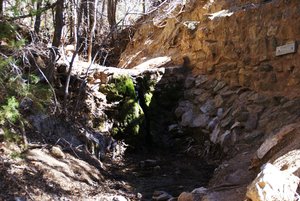Advertisement
Published: February 27th 2013

 APACHE SRING
APACHE SRING
The spring and battlefield are located on land administered by the Fort Bowie National Historic Site. You can reach Fort Bowie from Dos Cabezas to the west, or from the little town of Bowie to the North.PRECIOUS WATER
Everyone who came into or left Arizona from or to the east refreshed himself and his livestock at the spring in Apache Pass: every settler, every traveler, every soldier, and every Apache. Cochise and his father-in-law, Mangas Coloradas, realized that if they could control this spring and deny access to it their enemies would perish. In July of 1862 the Apaches fortified the high ground around the spring and determined to hold it with 500 warriors. Captain Sherrod Hunter and Company A of the Arizona Ranger Regiment, CSA made their retreat through Apache Pass before the blockade at the spring was in place. Federal forces that were advancing from California to New Mexico were too late to participate in the Confederate invasion that took place there, but they were right on schedule to engage the Apaches. The lead element was led by Captain Thomas L. Roberts of Company E, First California Infantry, accompanied by two 12-pounder mountain howitzers, a twenty-two man cavalry escort from Company B, Second Regiment California Cavalry led by Captain John C. Cremony, and twenty-one wagons plus 242 mules and horses. The infantrymen approached the spring about noon on July 15.

 BATTLE OF APACHE PASS
BATTLE OF APACHE PASS
The photo was taken from the artillery position. The Apache breastworks were on the hill to the right. Fort Bowie was built on that hilltop. The spring is situated in the canyon to the left of the hill.Those soldiers were hot and dreadfully thirsty but could not reach the spring. After a sharp fight they were forced to withdraw to the stage station and wait for the rest of the column to come up. Later in the afternoon the soldiers launched an assault and with artillery support succeeded in driving the Apaches out of their breastworks and reached the spring. Next morning the fight resumed, but when the artillery once again spoke the Apaches withdrew. In due course Colonel James H. Carleton, commander of the California Brigade, refreshed himself at the spring, saw its value, and decided a fort was needed to protect that precious water supply. Fort Bowie was built on the hilltop where the Apache breastworks were. The fort was named in honor of George Washington Bowie, commander of the Fifth California Volunteer Infantry Regiment who built the fort and manned it until the whole unit was mustered out after the Civil War ended. On the day after the battle as Roberts and Cremony passed through the other side of Apache Pass they found and buried the scalped bodies of nine miners who fell short of reaching the spring too. The photos show the contested spring, and the battlefield from the artillery position.
Advertisement
Tot: 0.23s; Tpl: 0.021s; cc: 6; qc: 45; dbt: 0.1114s; 1; m:domysql w:travelblog (10.17.0.13); sld: 1;
; mem: 1.1mb

 APACHE SRING
APACHE SRING
 BATTLE OF APACHE PASS
BATTLE OF APACHE PASS